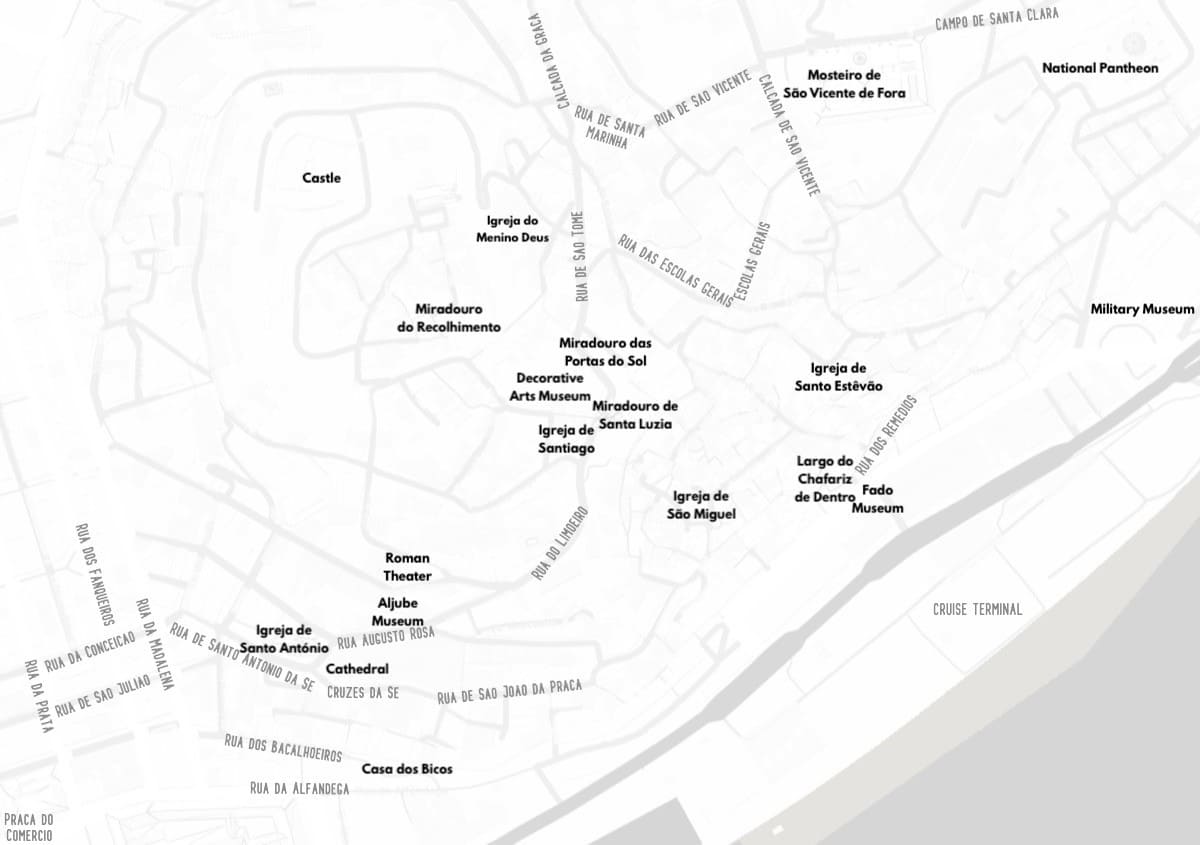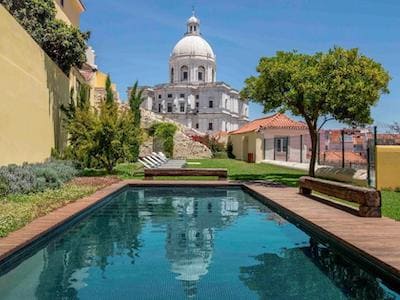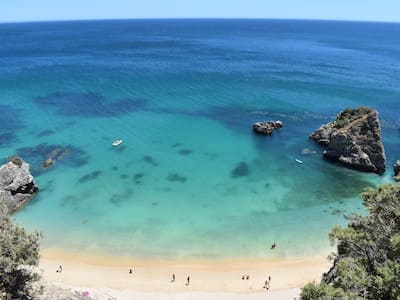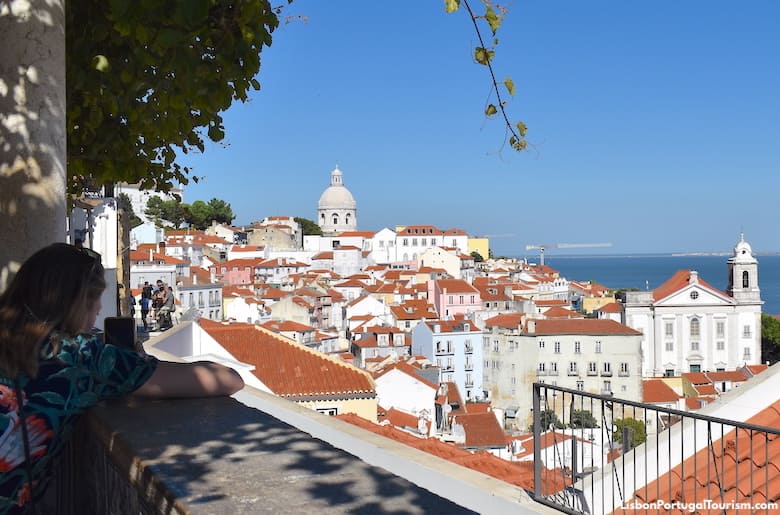
View of Alfama from the Santa Luzia viewpoint
Village-like Alfama is one of Europe’s oldest neighborhoods. It was settled as far back as the Iron Age, and later occupied by the Romans, Visigoths and other Germanic tribes, before becoming the heart of Moorish Lisbon. With the conquest of the city by Portugal’s first king in 1147, the Moors were either killed in the siege or segregated in Mouraria, and Alfama became home to the upper classes. It was also the Jewish quarter, until the Jews were expelled (together with all other non-Christians who didn’t convert) in 1497. As Lisbon expanded, the wealthy residents moved west, leaving Alfama to the fishing community.
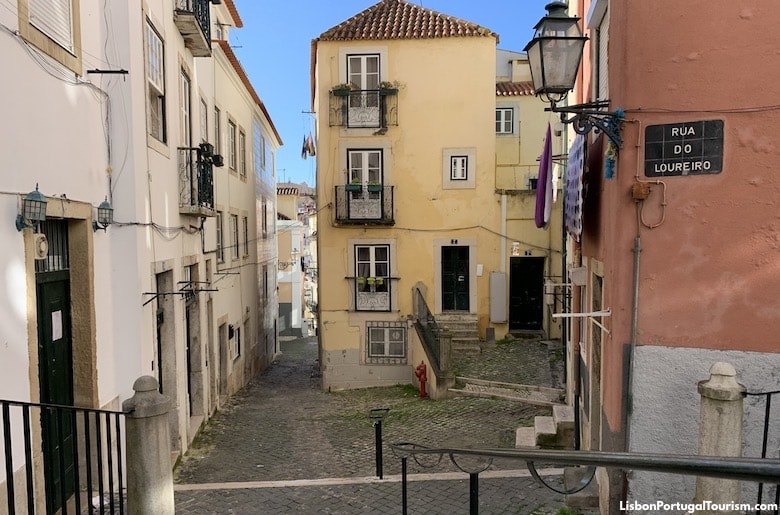
One of the many picturesque corners of Alfama
Thanks to its dense bedrock foundations, it was practically the only neighborhood that wasn’t greatly affected by the disastrous 1755 earthquake. Its maze of cobbled “becos” (alleys), “escadinhas” (steps) and “largos” (small squares) is just as it was centuries ago, and it’s a joy to wander around, finding unexpected river views and incredibly picturesque details.
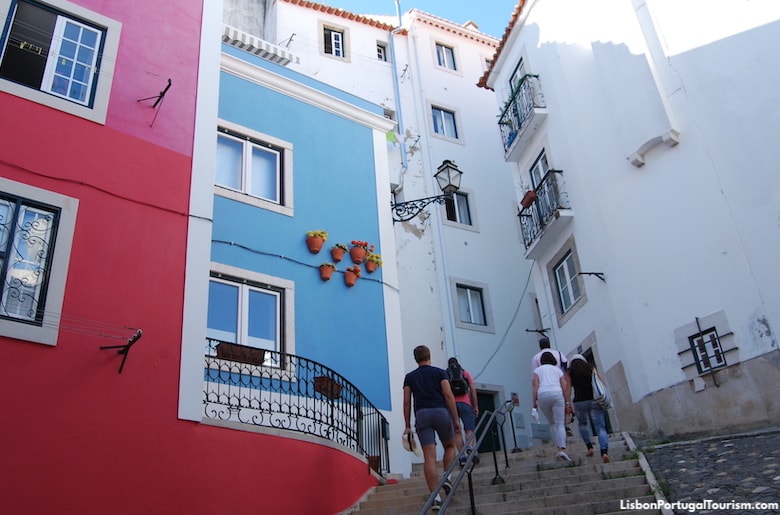
Colorful houses on Rua da Galé in Alfama
You don’t really need a map, just your camera -- all you need to know is that if you continue going down the hill you’ll eventually reach the waterfront and downtown, while uphill is the castle and the tram tracks (at the very top is the neighborhood of Graça).
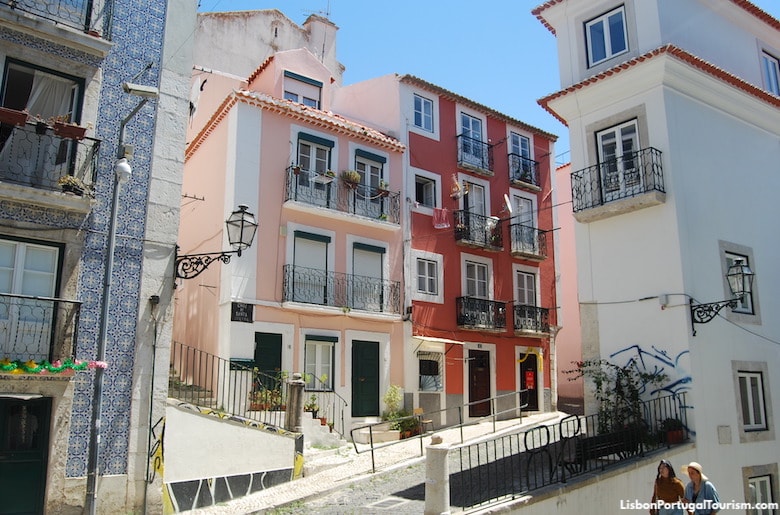
Typical Alfama buildings on Calçada de São Vicente
Long overdue restoration of the pastel-colored and tile-covered buildings started in the last decade, leading to gentrification and fears that the neighborhood will lose its soul together with its long-time residents. Many of the renovated buildings were turned into tourist apartments and hotels, but there’s still plenty of local color, as the sound of fado music echoes from an open window, elderly ladies chat across balconies with laundry out to dry, sardines are grilled in a corner during a street festival, and cats laze in the sun.
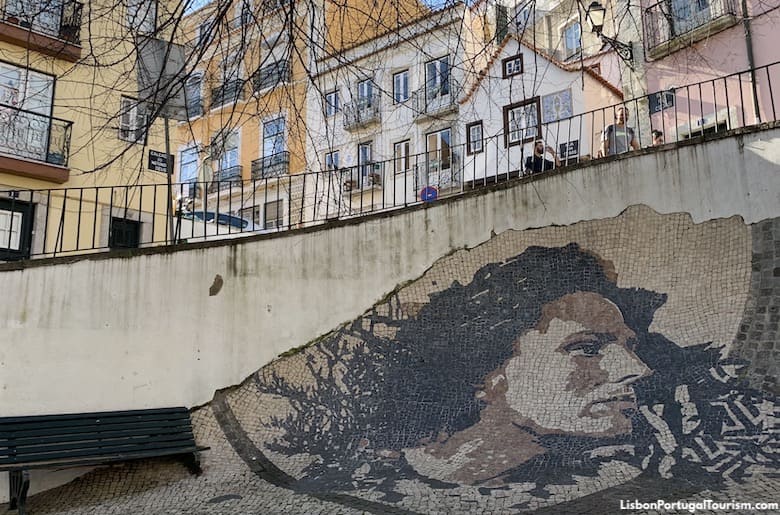
Cobblestone tribute to fado singer Amália Rodrigues on Rua de São Tomé in Alfama
In June (or throughout the summer, really), Alfama is a colorful and lively place, as Lisbon celebrates its annual street festivals, the Festas de Lisboa (see below).
What to See and Do in Alfama
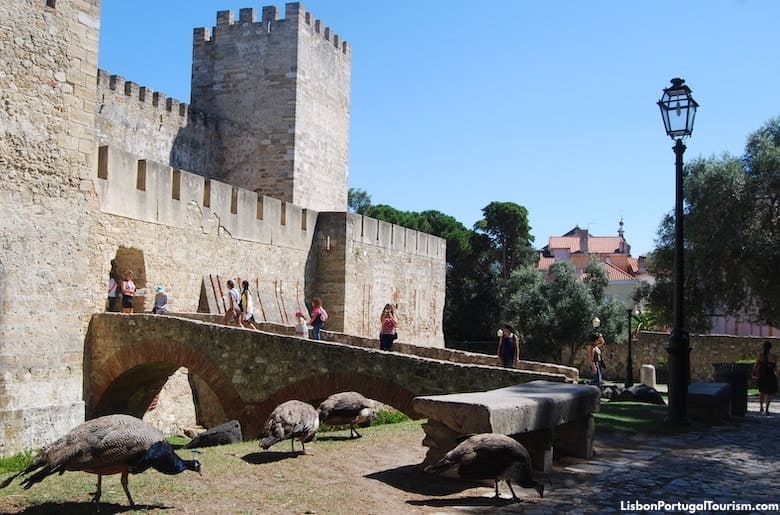
Crowning Lisbon for over a millennium, this castle offers breathtaking views of the city draped over its series of hills. Peacocks roam around the landscaped area around the towers, which house a small museum displaying pieces dating back to the site’s Moorish occupation. Within the restored walls is also a tiny picturesque neighborhood.
See the St. George's Castle Visitor's Guide.
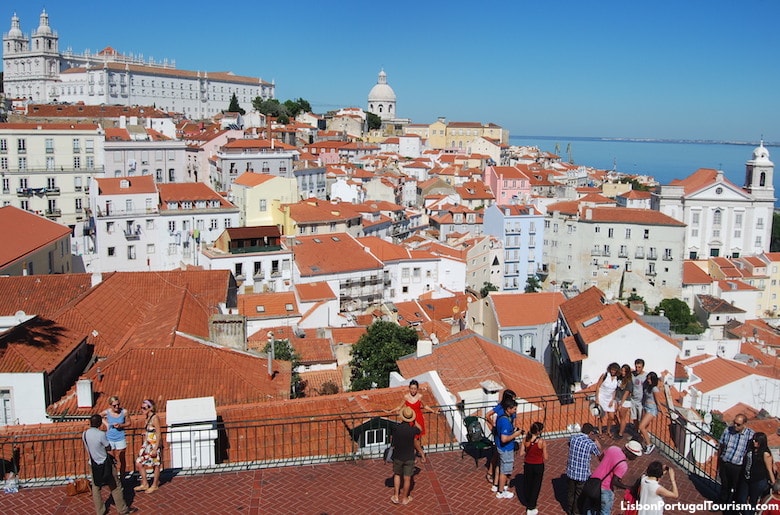
A statue of St. Vincent welcomes you to this terrace which offers the best view of old Lisbon. It’s the city’s must-see viewpoint, and an irresistible stop for photos. Street musicians provide a lively soundtrack, and there’s a kiosk serving refreshments, perfect for after a visit to the castle nearby.
See the Portas do Sol Viewpoint Visitor's Guide.
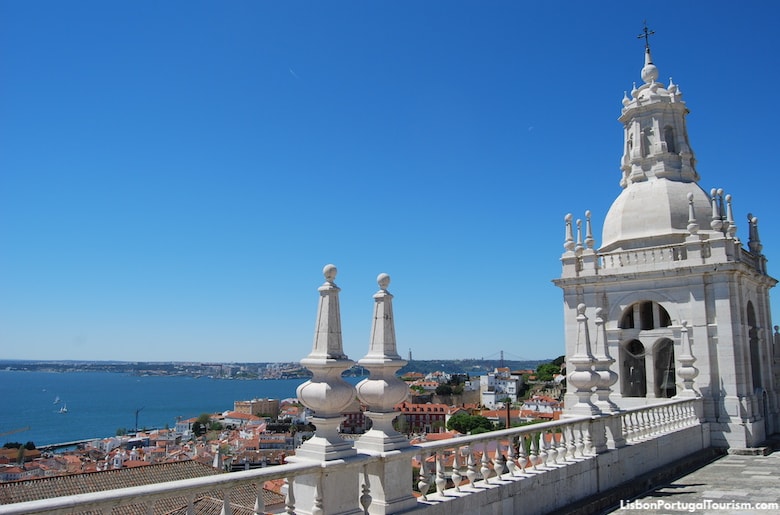
This monastery dedicated to St. Vincent dates from 1582, and has the world's most extensive collection of baroque decorative tiles in its richly-decorated cloisters. It includes a series of 38 panels illustrating the fables of La Fontaine, created by master Policarpo de Oliveira Bernardes between 1740 and 1750. Other panels depict scenes from the history of Portugal, including one showing the siege of Lisbon in 1147. There’s also an ancient cistern and the pantheon of the Bragança dynasty, which includes the tomb of Catherine of Bragança, the Portuguese princess who became the queen of England when she married King Charles II in 1662 (the borough of Queens, in New York, was named in her honor).
From the rooftop is a wonderful view of Alfama, over the river and the dome of the National Pantheon.
See the São Vicente de Fora Monastery Visitor's Guide.

Almost nine centuries old, Lisbon’s cathedral is one of the city’s oldest monuments. It mixes different architectural styles, and its gothic cloister is also an archaeological site. By the entrance is the font where St. Anthony was baptized in 1195, while upstairs is the treasury, displaying priceless sacred art.
See the Lisbon Cathedral Visitor's Guide.
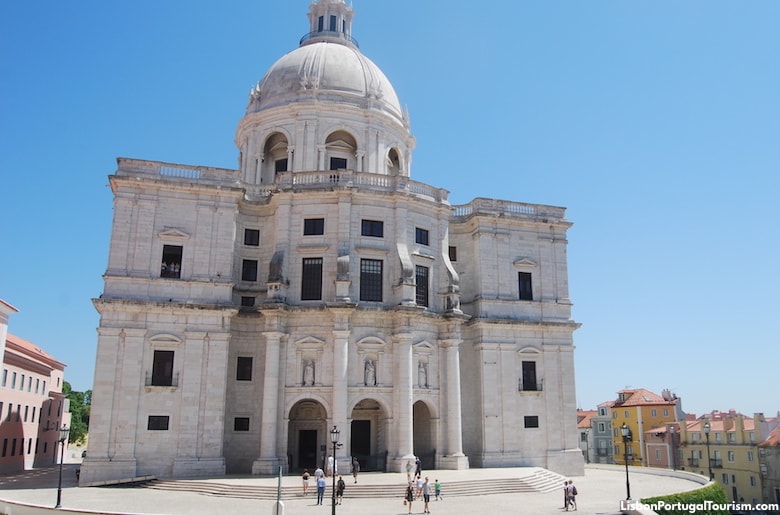
Holding the tombs of Portugal’s most illustrious personalities, this church took 285 years to complete. It features a huge dome, from which you can admire a view over Alfama.
See the National Pantheon Visitor's Guide.
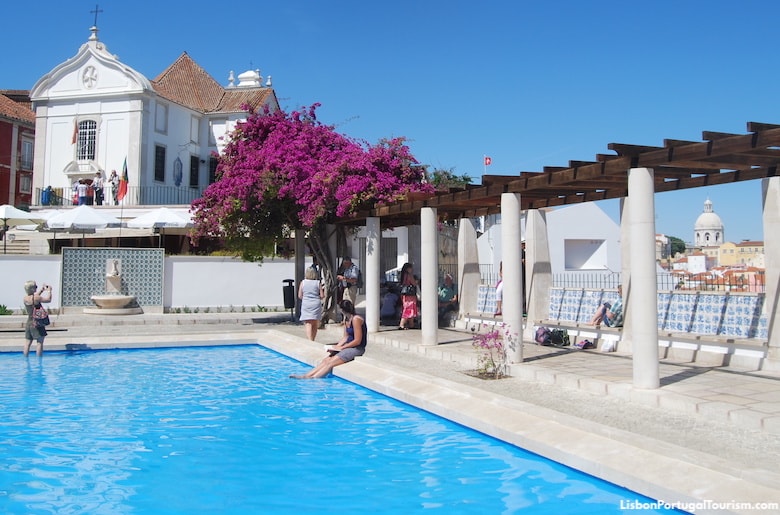
A white church with its back turned to the Portas do Sol viewpoint hides a terrace that’s essentially a balcony over Alfama. Many find it to be Lisbon’s most beautiful and most romantic viewpoint, as it’s adorned with historic tiles and bougainvillea, and the view is framed by a vine-covered pergola. It’s divided into two levels, with the lower one featuring a reflecting pool.
See the Santa Luzia Viewpoint Visitor's Guide.

One of Lisbon’s most striking buildings is one of the few survivors of the 1755 earthquake. Built as the home of the viceroy of Portuguese India in 1523, it’s covered in over 1000 diamond-shaped stones outside, while inside it presents an archaeological site with traces of Lisbon life from the past 2000 years, and an exhibition space dedicated to the life and work of Nobel Prize author José Saramago.
See the Casa dos Bicos Visitor's Guide.
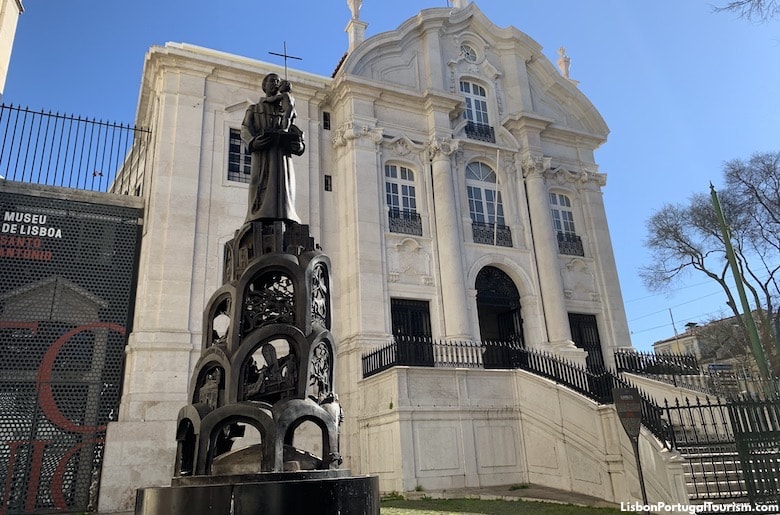
This church is found right across from the cathedral, on the site where St. Anthony was born in 1195. A statue of him holding baby Jesus stands by the entrance. Unlike the cathedral, this church, which was originally built in the 1400s, was greatly damaged by the 1755 earthquake and rebuilt in 1757. It mixes the baroque and the neoclassical, and holds the remains of St. Justina, which were transferred from Rome in 1777 by Pope Pius VI. In the crypt (the actual birthplace of St. Anthony) is a contemporary tile panel illustrating the visit that Pope John Paul II made to this church in 1982. Next door is one of the branches of the Lisbon Museum, completely devoted to the life and worship of St. Anthony, with paintings, sculptures, and manuscripts.
See the Igreja de Santo António Visitor's Guide.

It’s almost always closed, but it’s still worth stopping by this church dedicated to St. Stephen, as there is a view over Alfama from the terrace beside it. Those lucky to find the monument open (usually on Sunday mornings), will see a fine example of Portuguese baroque architecture.
See the Igreja de Santo Estêvão Visitor's Guide.
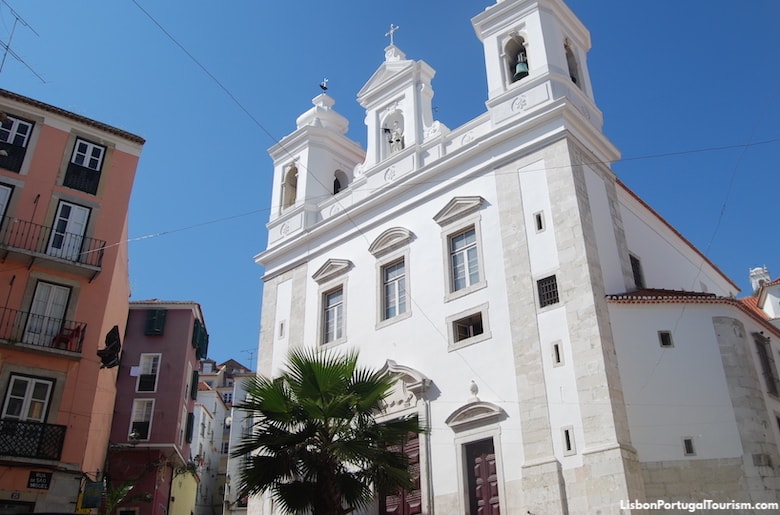
The main church in Alfama is dedicated to St. Michael and faces the tiny square at the center of the neighborhood’s maze of streets. Unfortunately it only opens once or twice a week for services, but has a stunning golden interior that partly survived the 1755 earthquake.
See the Igreja de São Miguel Visitor's Guide.
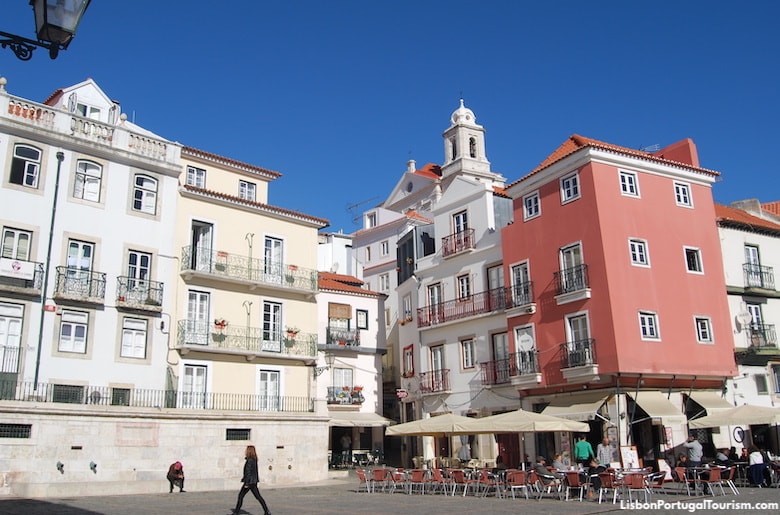
This small square is named after its 13th-century fountain that may actually have Roman origins. It’s the Chafariz de Dentro (“Inner Fountain”), for its location inside the city’s medieval wall, but it was originally called Chafariz dos Cavalos (“Fountain of the Horses”), for the bronze spouts shaped like a horse’s head. Over the centuries it quenched the thirst of the people of Alfama and their animals, and was even used as a tank to wash clothes. Restored in 1622 and again in 1872, it was neglected for much of the 20th century, until a new restoration in 2017, when it regained its drinking water. Across the fountain is a former reservoir, built in 1868 as a solution to the city’s lack of water. The building was restored in 1998, when it was turned into the Fado Museum (see below). Other attractions around the square are the traditional old houses (some from the 1600s) that are now renovated, many with outdoor cafés and restaurants where tourists sit in the sun. From here you can also see the Church of St. Stephen (listed above) and, heading in the direction of Rua de São Pedro, two curious Ionic columns. These hold up the façade of a building, and may have come from a church that was destroyed in the 1755 earthquake or perhaps from a portico on the fountain. Other buildings that survived the earthquake are found on Rua dos Remédios, one of Lisbon’s most picturesque streets, to the east of the square.
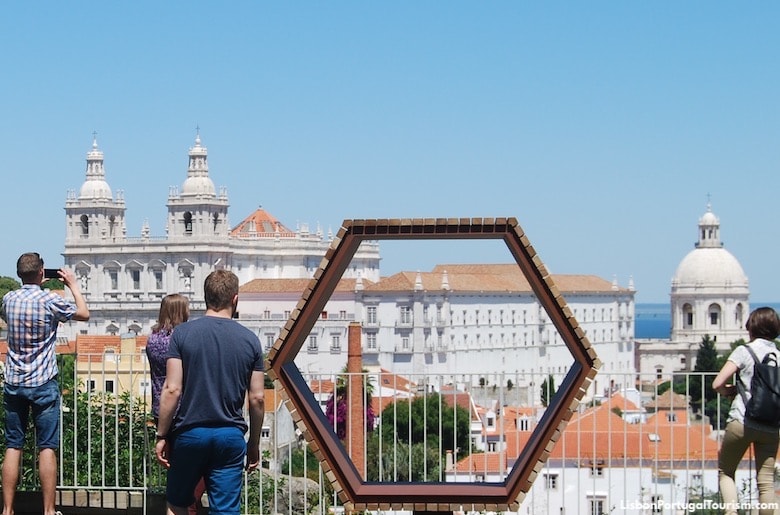
A landscaped terrace hidden on a street within the castle walls opened to the public for the first time in 2015. It has a children’s playground, but is mostly visited by tourists who find it by chance. It remains a secret, despite offering one of the best panoramic views of Alfama. The gate closes at 7pm, but this is a good spot to relax after a visit to the castle, in the shade of olive trees.
See the Recolhimento Viewpoint Visitor's Guide.
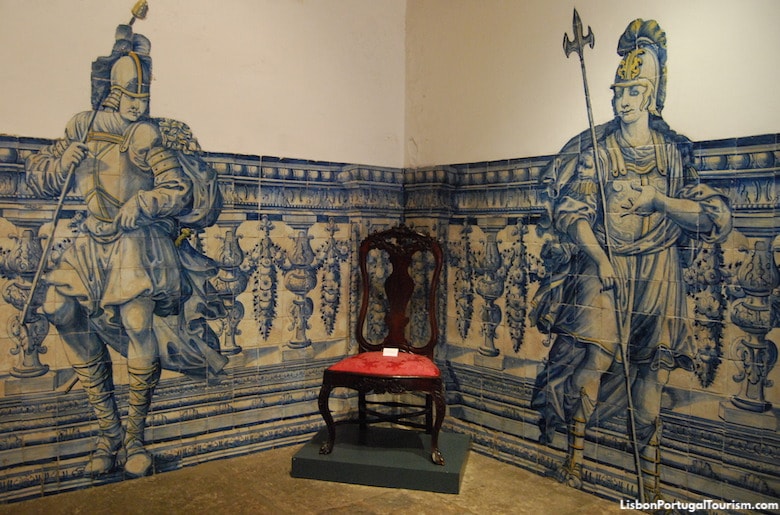
Housed in a 17th-century palace, the Decorative Arts Museum presents a collection of 16th- to 19th-century Portuguese and other European (mostly French and English) furniture and tapestries. The interior of the palace alone would be worth a visit, with its beautiful tile panels and painted ceilings.
See the Decorative Arts Museum Visitor's Guide.
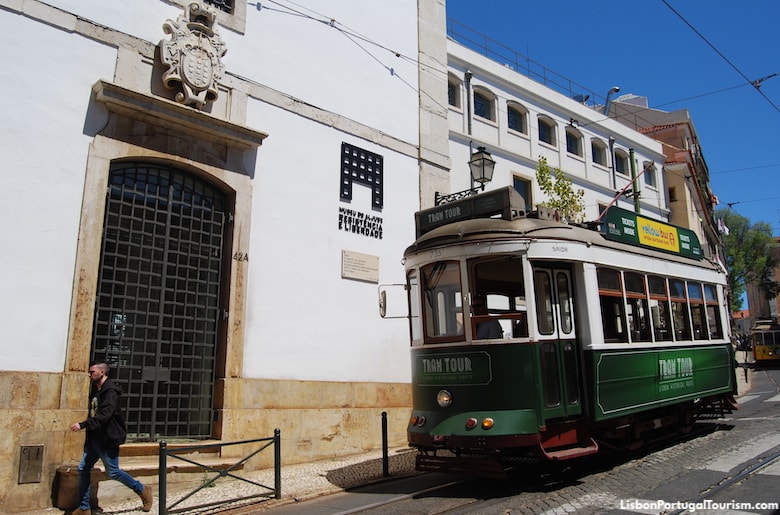
This former prison documents Portugal’s 20th-century political history, particularly the fascist regime that lasted until 1974. It’s quite fascinating, as it reminds visitors of the long fight for freedom and independence for the Portuguese colonies, and the struggles against censorship. It also shows the tiny, claustrophobic cells where political prisoners spent their days, and how they were interrogated and tortured.
See the Aljube Museum Visitor's Guide.
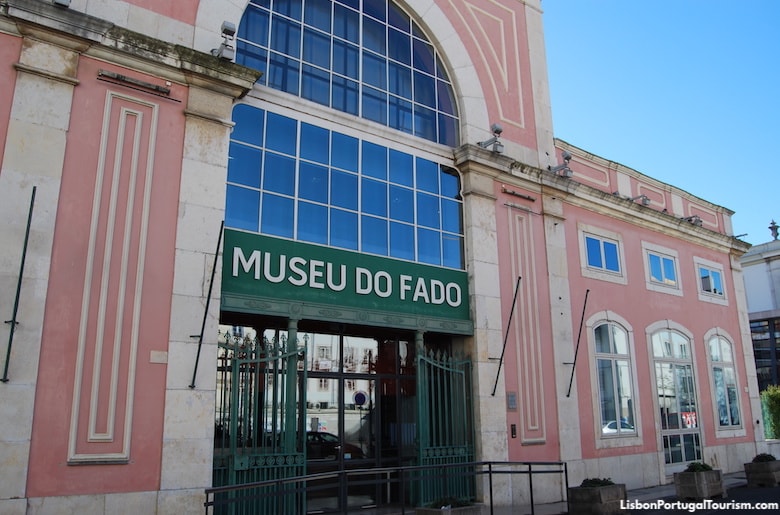
UNESCO placed fado on the World Heritage list in 2011, but the music that was born on Lisbon’s streets has long been recognized for its cultural significance. It even has its own museum since 1998, where visitors can listen to songs from the past and present, and see instruments, photographs and other pieces related to the people and history of the genre.
See the Fado Museum Visitor's Guide.
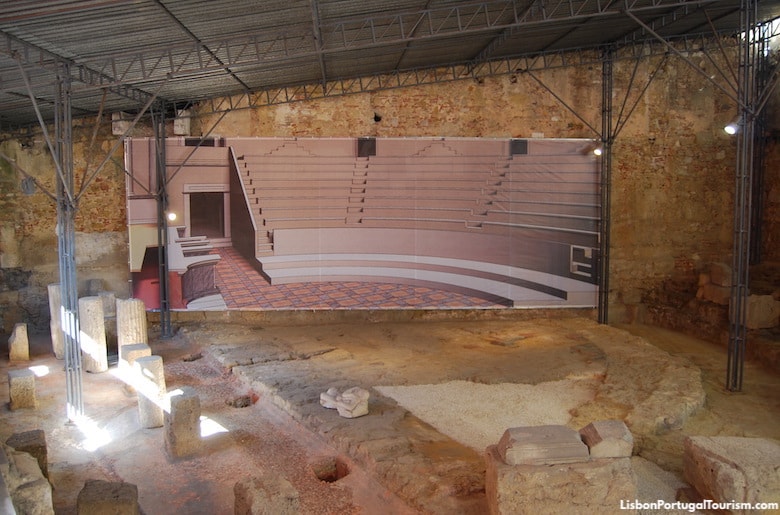
In Roman times, it was quite a sizeable theater, seating as many as 4,000 spectators, but all that remains is a small part that was unearthed over the last century. It stands behind a small museum that tells the story of Roman Lisbon, through pieces found during the excavations.
This is a branch of the Lisbon Museum.

The Military Museum is Lisbon’s oldest museum, but is one of the city’s least-visited attractions. Those who find it by chance are always pleasantly surprised, as they tour its several sumptuous rooms named after national heroes like Vasco da Gama and Prince Henry the Navigator. On display is a huge collection of artillery, swords that belonged to Portugal’s kings, and replicas of 16th-century armor. On the cannon-filled courtyard are tile panels illustrating Portugal’s historic battles against its neighboring kingdoms.
See the Military Museum Visitor's Guide.
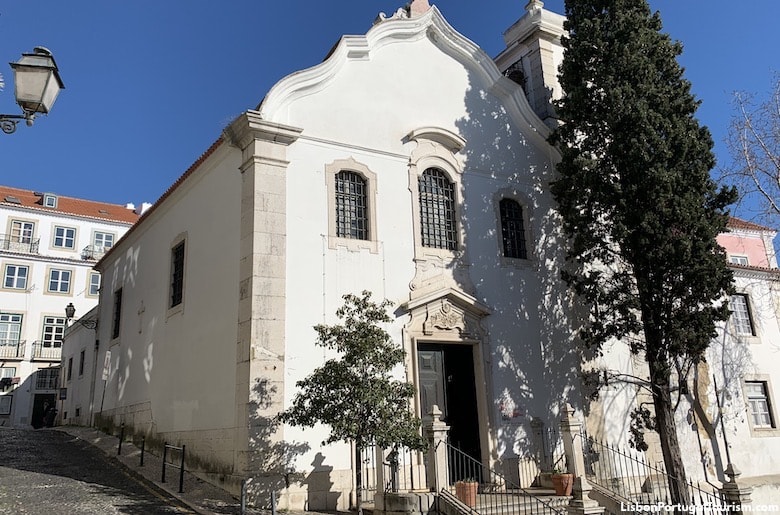
The small church of St. James was where explorer Christopher Columbus married his Portuguese wife Filipa Perestrelo in 1479. It dates from the 1100s, but was almost completely rebuilt after the 1755 earthquake. It’s found between the castle and the Santa Luzia viewpoint, and is the starting point of the Portuguese Way of St. James. It has a plain façade and a single bell tower, but holds several treasures inside, especially the remarkably gilded altarpiece and the 19th-century tile panels illustrating the "Mysteries of the Life of the Virgin.”
See the Igreja de Santiago Visitor's Guide.
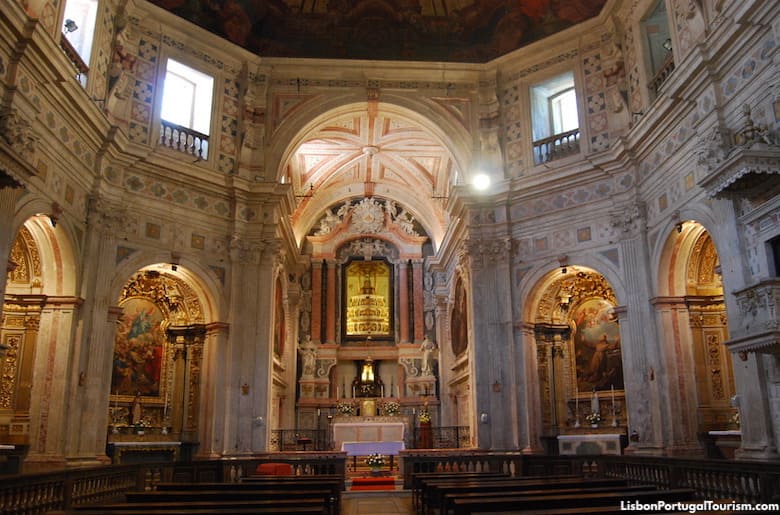
It opened its doors to the public on July 4th, 2011 for its 300th anniversary, but this church is usually closed to visitors. To go inside, you'll have to ring the bell next to the main entrance. The interior hides one of the most impressive baroque churches in the city that served as a model for many other baroque buildings in the country. It was built during the golden years of King João V in the 18th century, adorned with marble and paintings by some of the greatest local artists of the time. All of it somehow survived the earthquake of 1755, as did one of the houses that can be seen right outside. Painted yellow, it's one of the oldest still standing in the city, and is a rare example of the architecture at the Age of Discovery. A second example is just around the corner on Rua dos Cegos.
Largo do Menino Deus
Usually closed; ring the bell for access.
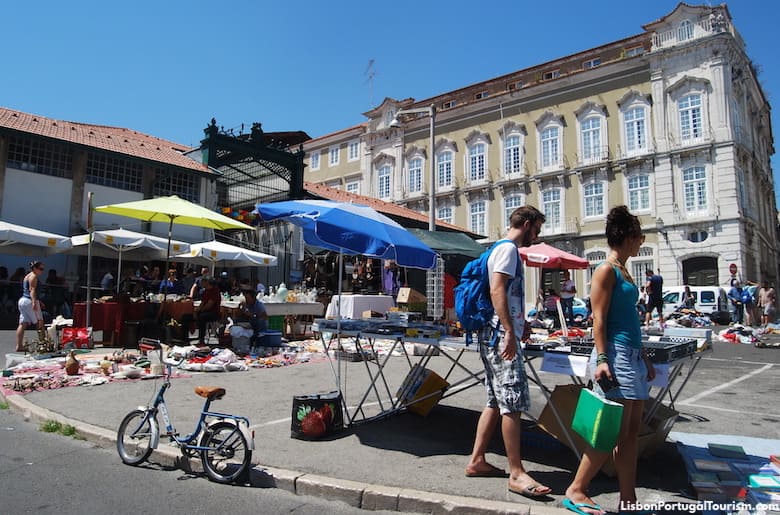
Lisbon's flea market is a destination for bargains and treasure hunting on Saturday and Tuesday mornings. It occupies the street behind the National Pantheon and has more junk than real treasures, but it can be fun finding oddities in between it all. It's not uncommon to have a price bargained down. Because "ladra" means female thief, many translate the name to "the thieves' market.” However, the origin of the name is a derivation of "ladro" or “piolho ladro”, meaning a bug or flea.
Campo de Santa Clara
Saturday and Tuesday mornings
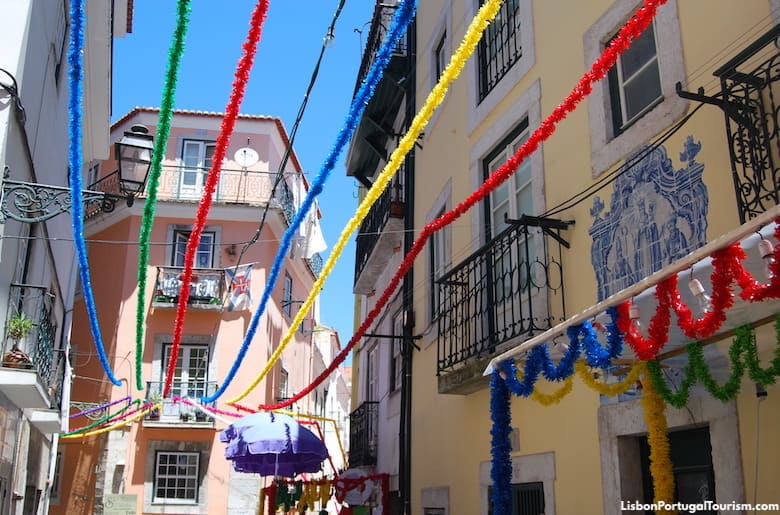
If you’re in Lisbon between late May and July, you’ll see the city at its most festive, especially in Alfama. What was once an event of just a couple of days (on June 12 and 13, the feast of St. Anthony) is now a major festival lasting over a month. The city’s oldest neighborhoods (Alfama, Bairro Alto, Bica and Mouraria) turn into big street parties, especially on the night of June 12, with outdoor grilling (sardines and pork), beer-drinking and dancing to folksy music. The celebration honors other "popular saints" besides St. Anthony, but isn’t religious. The highlight is a colorful parade down Avenida da Liberdade, with every Lisbon neighborhood represented in costume and song, competing for "best march." Another special event is the "Brides of Saint Anthony," a collective wedding ceremony in the cathedral, which also stops by Saint Anthony Church (the saint was known as a matchmaker). You'll see lots of potted "manjericos" (basil plants), traditionally used in Lisbon to declare undying love. Although the festival happens in different neighborhoods, Alfama’s maze of car-free streets is the main stage.
How to Get to Alfama

The best way to reach Alfama would be by tram 28, but it’s always so crowded, that you’re better off walking from downtown, following the tracks. Although it’s an uphill climb, it’s less than a 10-minute walk, past the cathedral to the castle and the viewpoints nearby. Alternatively, take bus 737, which departs every 10 minutes from Praça da Figueira (every 15 or 30 minutes on weekends) and goes up to the castle, past the cathedral. The viewpoints and the maze of Alfama are just around the corner from the final stop, at the gate of the castle.
You may ride the tram and the bus for free with the Lisboa Card.
Where to Eat and Drink in Alfama
When in Alfama, head to the waterfront for meals at any time of the day. The restaurants in the converted warehouses across the road from Santa Apolónia Station open for lunch and continue to serve until dinner – you have the choice of some of Lisbon’s best pizzas (at Casanova) and burgers (at Ground Burger), with outdoor seating. Also in the vicinity of the train station you find two small, very recommended restaurants for traditional Portuguese food – Taberna Sal Grosso and Taberna Albricoque. These two usually have good daily specials and maintain the look and atmosphere of classic Lisbon restaurants. For meals with a view, head up towards the castle and dine with Lisbon at your feet at Chapitô à Mesa. For creative, signature cuisine, look for Prado close to the cathedral.
Where to Stay in Alfama
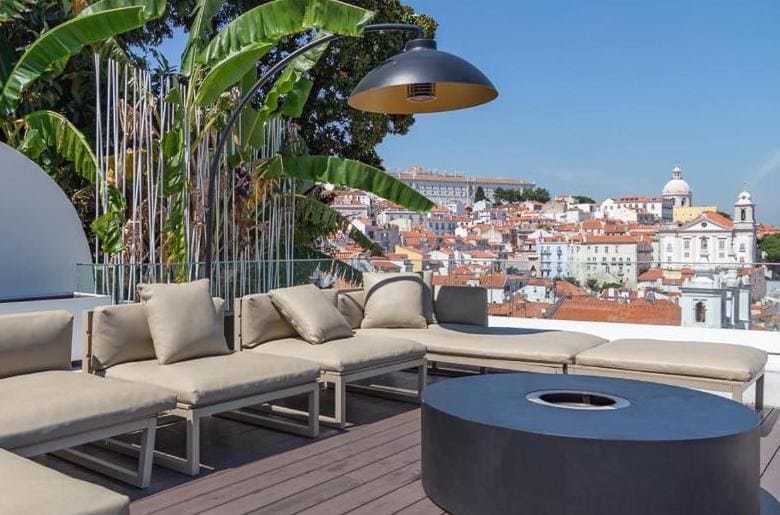
Alfama is home to some of Lisbon’s most beautiful hotels. Some are converted palaces, and many offer wonderful views. The Memmo Alfama design hotel offers the best view, while Palacete Chafariz D’el Rei has the most stunning interior. By the castle are Solar do Castelo and Solar dos Mouros, both romantic boutique hotels. A few feet from the neighborhood’s viewpoints is another boutique property, the Santiago de Alfama.
There are also some of the most charming apartments in the city, like the Patio São Vicente in a lovely courtyard next to the São Vicente de Fora Monastery, The Lisboans by the cathedral, and the beautiful Tandem Palacio Alfama Suites with an outdoor pool and view of the National Pantheon.
For more details and recommendations, see the best hotels in Alfama.
